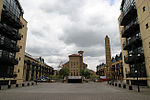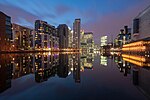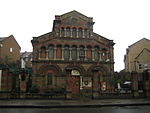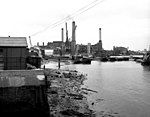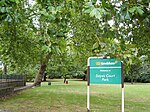The Foreign Cattle Market, Deptford (1872–1913) was one of the two great livestock markets of London; from it came about half the capital's supply of freshly killed meat. Situated at the former royal Deptford Dockyard on a bend of the River Thames and owned by the City of London, all animals came from overseas, were landed by cattle boat, kept under quarantine conditions, and had to be slaughtered within 10 days of disembarkation. None could leave the market alive: the purpose was to stop the importation of animal diseases. Besides cattle, the market handled sheep, pigs and a few others. It could shelter 8,500 cattle and 20,000 sheep at a time, and had 70 slaughterhouses.
More than a set of buildings in Deptford, it had trading links with four continents: part of what has been called the first globalisation. Cattle were brought there from the great grasslands of the world: initially, from Western Europe, Austria-Hungary and the steppes of the Russian Empire 30° to the east; but later, and mostly, from the Great Plains of America, literally being rounded up by cowboys. Such was the volume and quality of the trade that it had a appreciable impact on the livestock industry of the American and Canadian West. Boats also brought live animals across the equator from the pampas of Argentina, and even from the other side of the globe: Australia and New Zealand.
In stormy weather numbers of animals were fatally injured, washed overboard, or jettisoned to save the vessel; others were stifled to death under closed hatches. Prior to the sea voyages most had endured long journeys on tightly packed cattle trains. Both on trains and ships severe methods were used to make recumbent cattle stand up—in case they were trampled to death. The intercontinental traffic in live animals was not actually necessary, because it was cheaper to import chilled meat, which was of good quality. Yet the Foreign Cattle Market survived for 40 years; possibly because of irrational prejudice, possibly because butchers could pass off Deptford-killed meat as Scotch or English meat, which sold at a premium.

